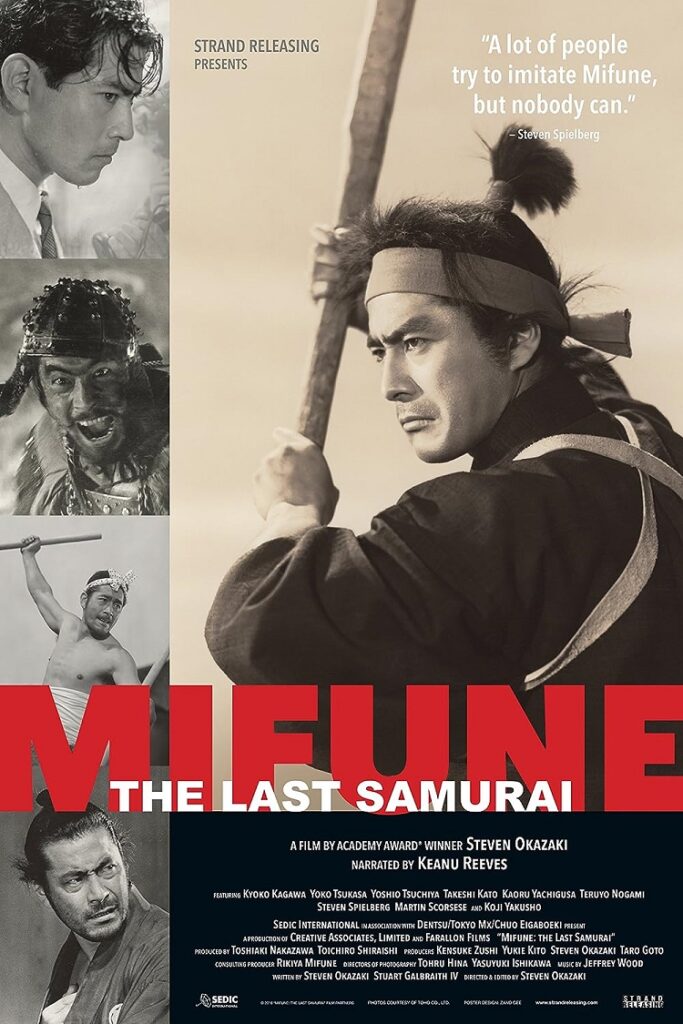
Toshiro Mifune is one of the most dynamic actors who’s ever played on the big screen. He was an animal presence that made it difficult to look away. Even in one of Akira Kurosawa’s more staid productions, the stagy and fairly drab The Lower Depths, comes to life when his character comes on screen for an unfortunate few times. In combination with Akira Kurosawa, he made one of the definitive actor/director teams who shaped the future of Japanese cinema, helping to bring it to international attention for the first time in 1950’s Rashomon.
Mifune: The Last Samurai, a feature-length documentary about the actor, does a fine job of bringing the story of the man’s life and his work into focus and context. It’s just in time, too, because many of the people who lived and worked with Mifune have passed away, and first-hand accounts from contemporaries are thin on the ground. Through interviews with other actors and on-scene players, including a fight choreographer whom a caption claims has been killed on-screen more than 100 times by Toshiro Mifune, an interesting dual portrait of the man is presented: the consummate professional who studied his roles intensely and arrived fifteen minutes ahead of his call times, and the lover of fast car and hard liquor who hadn’t set foot in Japan before he was 20 and drafted into the army, never to see his parents again, and who only later became an actor out of desperation in war-torn Japan.
Mifune builds its profile of its subject in a methodical, straightforward fashion: first detailing a brief history of the industry he eventually went into, with plenty of fun clips from very old silent Japanese ‘Chanbara’ sword-fighting movies. Then it moves to Manchuria and the early life of Toshiro, who was often a model for his father’s struggling photography business. This portrait of his early life paints a Toshiro who, though he had no desire to be an actor was gifted with both a presence (his superiors would routinely beat him for appearing too arrogant) and an almost contradictory deep well of sympathy: when the men he was responsible for training went off base on literal suicide missions, he would tell them “you don’t have to say Banzai for the emperor, just say goodbye to your mother.”
Akira Kurosawa was the director who best utilized Mifune’s animal magnetism, particular in the many period films they made with one another. Mifune‘s Director Steve Okazaki, a Japanese-American filmmaker, wrote Mifune with Stuart Gailbraith IV who himself wrote an exhaustive study of the working relationship, The Emperor and the Wolf.
Mifune: The Last Samurai is not exhaustive. The reasons for Mifune’s apparent falling out with Kurosawa are left a mystery. In his interview his son notes that, when drunk, Mifune would occasionally take out an old sword and wave it around dangerously, and nearly every interview alludes to the man’s hidden depths. Mifune: The Last Samurai doesn’t plumb those depths, but as a glide along the surface, it’s a pleasant ride. Keanu Reeves provides the narration, while interviews with Martin Scorsese and Steven Spielberg highlight the Western appreciation of Mifune’s impact, but most of the interviews are in subtitled Japanese. It’s fun to see the juxtaposition of Mifune’s often fierce on-screen persona with photographs of him in his personal life, often with a smile on his face. As a study of Japanese Cinema, Mifune: The Last Samurai is part of a 101 course, an illuminating introduction into a wider world.